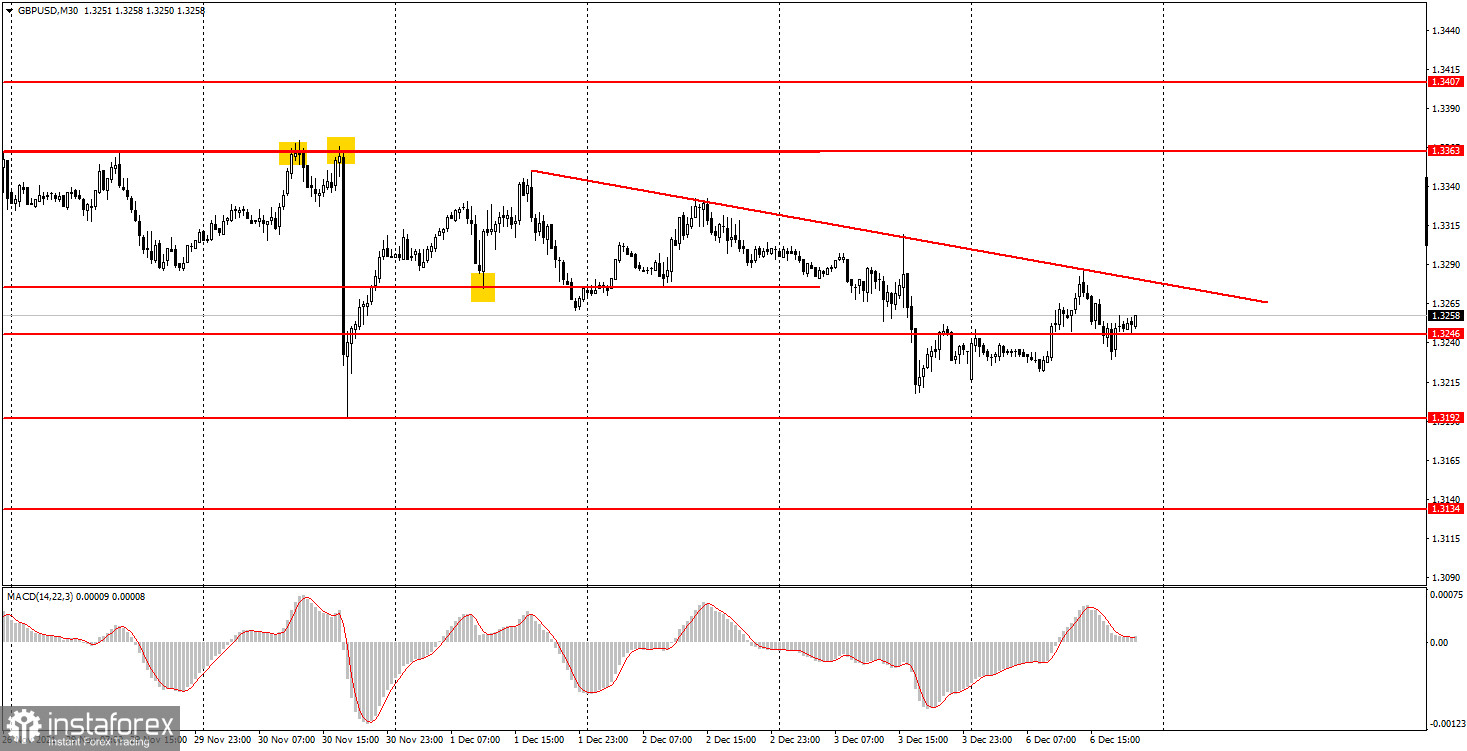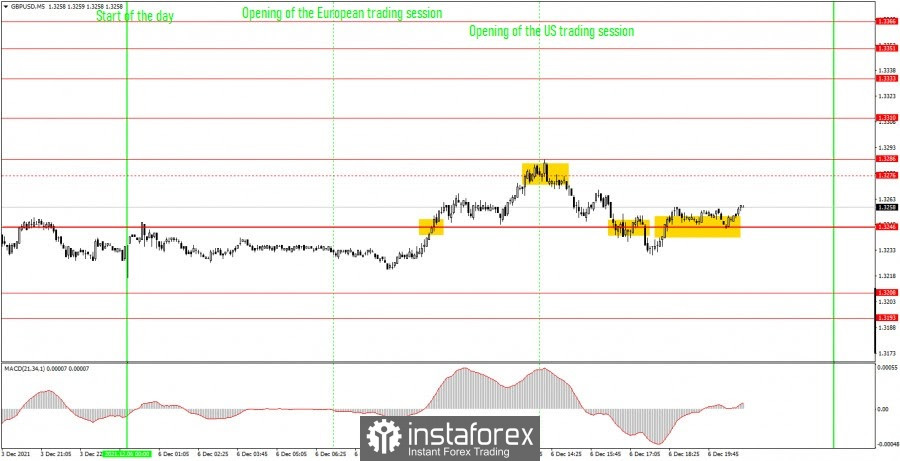Analysis of previous deals:
30M chart of the GBP/USD pair

The GBP/USD pair showed nothing interesting on Monday. In the first half of the day, a relatively good upward movement was observed, but in general the volatility was just over 60 points, which is about the same for the pound as for the euro - 40 points. That is, very little. At this time, a new downward trend has formed, which is supported by the downtrend line, from which the pair has already bounced four times. Thus, this trend line can be called strong. In particular, today a sell signal was generated near it, which could and should have been worked out. The rebound was accurate, and the price went down more than 40 points after it, which would be enough to trigger the Take Profit order. Therefore, we can already conclude that the day was not the worst. As for the macroeconomic statistics, only a report on business activity in the construction sector was published in the UK on Monday, which slightly exceeded forecasts. However, at the time of its release, the pair was already in an upward movement, so the pound's growth was hardly caused by this report.
5M chart of the GBP/USD pair

On a 5-minute timeframe, the movement of the pound/dollar pair on Monday does not look entirely unambiguous. The first buy signal was generated when the price crossed the 1.3246 level and should have been followed by a long position. The price subsequently rose to the level of 1.3276 (the level of 1.3286 is the high on Monday and was not yet reached during the day), and then bounced off the trend line at the 30-minute TF. Thus, it was precisely this signal that should have been used to close long positions (about 18 points profit) and open short positions, especially since a sell signal was also formed on the 30-minute TF. As we said above, this trade closed at 40 points profit at TP. Thus, we managed to earn about 60 points for two trades. It was no longer necessary to open long positions on the last signal, but even if the newcomers worked out this signal, they only earned a dozen more points of profit. Thus, although the movement of the pair was not the most beautiful, it was still possible to make good money on it.
How to trade on Tuesday:
At this time, there is a downward trend on the 30-minute timeframe, so it will persist until the downtrend line is broken. If the pair settles above it, it will be a signal to buy, and the trend will change to an upward one. Accordingly, a new bounce is a new sell signal. The important levels on the 5-minute timeframe are 1.3193, 1.3208, 1.3246, 1.3286, 1.3310, 1.3333. We recommend trading on them on Tuesday. The price can bounce off them or overcome them. As before, we set Take Profit at a distance of 40-50 points. At the 5M TF, you can use all the nearest levels as targets, but then you need to take profit, taking into account the strength of the movement. When passing 20 points in the right direction, we recommend setting Stop Loss to breakeven. There will be no major report or other event on December 7 in the UK and US. Thus, the pair may move very weakly tomorrow, but if the signals are the same as today, it will again make good money.
Basic rules of the trading system:
1) The signal strength is calculated by the time it took to form the signal (bounce or overcome the level). The less time it took, the stronger the signal.
2) If two or more deals were opened near a certain level based on false signals (which did not trigger Take Profit or the nearest target level), then all subsequent signals from this level should be ignored.
3) In a flat, any pair can form a lot of false signals or not form them at all. But in any case, at the first signs of a flat, it is better to stop trading.
4) Trade deals are opened in the time period between the beginning of the European session and until the middle of the US one, when all deals must be closed manually.
5) On the 30-minute TF, using signals from the MACD indicator, you can trade only if there is good volatility and a trend, which is confirmed by a trend line or a trend channel.
6) If two levels are located too close to each other (from 5 to 15 points), then they should be considered as an area of support or resistance.
On the chart:
Support and Resistance Levels are the Levels that serve as targets when buying or selling the pair. You can place Take Profit near these levels.
Red lines are the channels or trend lines that display the current trend and show in which direction it is better to trade now.
The MACD indicator consists of a histogram and a signal line. When they cross, this is a signal to enter the market. It is recommended to use this indicator in combination with trend lines (channels and trend lines).
Important speeches and reports (always contained in the news calendar) can greatly influence the movement of a currency pair. Therefore, during their exit, it is recommended to trade as carefully as possible or exit the market in order to avoid a sharp price reversal against the previous movement.
Beginners on Forex should remember that not every single trade has to be profitable. The development of a clear strategy and money management are the key to success in trading over a long period of time.
 English
English 
 Русский
Русский Bahasa Indonesia
Bahasa Indonesia Bahasa Malay
Bahasa Malay ไทย
ไทย Español
Español Deutsch
Deutsch Български
Български Français
Français Tiếng Việt
Tiếng Việt 中文
中文 বাংলা
বাংলা हिन्दी
हिन्दी Čeština
Čeština Українська
Українська Română
Română

